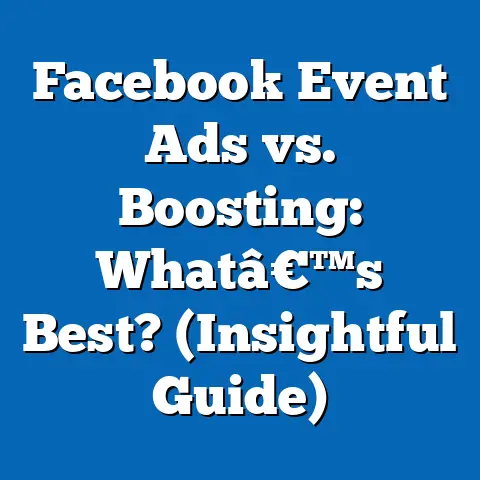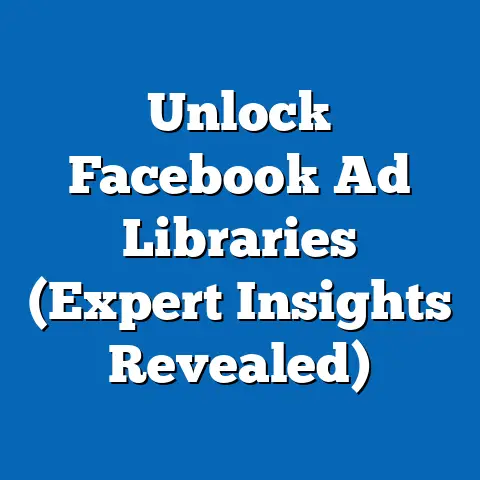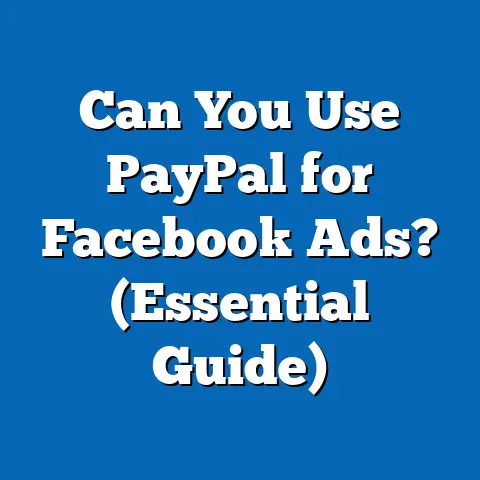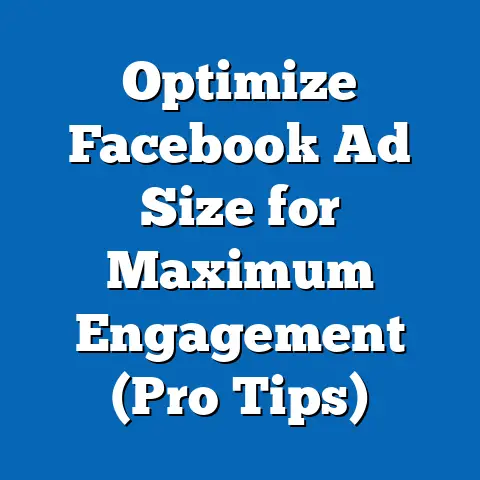Transform Facebook Ad Agency Account (Proven Strategies)
The digital advertising ecosystem, particularly on platforms like Facebook, has experienced significant wear-and-tear over the past decade due to oversaturation, evolving algorithms, and shifting user behaviors. According to a 2022 report by eMarketer, global digital ad spending reached $567 billion, with social media platforms like Facebook (Meta) accounting for approximately 33.5% of that share, or roughly $190 billion. However, despite this growth, advertisers are facing diminishing returns, with average cost-per-click (CPC) on Facebook rising by 17% year-over-year in 2022, while click-through rates (CTR) dropped by 2.5% during the same period.
This wear-and-tear is particularly pronounced for ad agency accounts managing multiple clients, where inefficiencies in strategy, targeting, and creative optimization can erode profitability. A 2023 survey conducted by Social Media Examiner, which polled over 3,000 marketing professionals between November 2022 and January 2023, found that 62% of agencies reported challenges in maintaining consistent ROI for clients on Facebook Ads due to increased competition and ad fatigue among audiences. These challenges underscore the urgent need for transformation in how agencies manage and optimize their Facebook Ad accounts.
Section 1: The Current State of Facebook Advertising – Trends and Challenges
1.1 Broad Market Trends
Facebook remains a dominant force in social media advertising, with 2.96 billion monthly active users (MAUs) as of Q2 2023, according to Meta’s quarterly earnings report. This represents a 3% year-over-year increase from 2022, though growth has slowed compared to the 6% increase observed between 2020 and 2021. Despite this slowdown, ad impressions on the platform grew by 10% in 2022, signaling that user engagement with ads remains robust even as competition intensifies.
However, the cost of advertising continues to rise. Data from Statista indicates that the average CPC on Facebook reached $1.72 in 2022, up from $1.47 in 2021, while cost-per-thousand-impressions (CPM) increased by 12% to $14.40 over the same period. These rising costs are driven by increased advertiser demand and Meta’s ongoing algorithm updates, which prioritize user experience over ad density, often reducing ad visibility for underperforming campaigns.
1.2 Demographic Usage Patterns
Understanding demographic trends is critical for agencies aiming to optimize their Facebook Ad accounts. According to Pew Research Center’s 2023 Social Media Use report, based on a survey of 5,733 U.S. adults conducted in May 2023, Facebook usage varies significantly across age, gender, race, and income levels:
- Age: While 68% of adults aged 18-29 use Facebook, adoption drops to 46% among those aged 65 and older. However, the 50-64 age group has shown a 5% increase in usage since 2021, making it a growing segment for targeted campaigns.
- Gender: Usage is relatively balanced, with 70% of women and 67% of men reporting regular use of the platform. Women, however, engage more frequently with content, spending an average of 25 minutes per session compared to 20 minutes for men, per a 2022 Nielsen study.
- Race/Ethnicity: Facebook usage is highest among Hispanic adults at 73%, followed by Black adults at 70%, and White adults at 65%. Engagement rates, however, show Black users are 8% more likely to interact with ads compared to White users, per a 2023 Sprout Social report.
- Income Level: Higher-income households ($75,000+) report 71% usage, compared to 66% for those earning less than $30,000 annually. Yet, lower-income groups show higher ad engagement, with a 12% higher CTR, likely due to targeted promotions and discounts resonating more strongly.
These demographic insights highlight the importance of tailored strategies, as different groups exhibit unique behaviors and engagement patterns that agencies must account for in campaign design.
1.3 Emerging Challenges and Pain Points
Agencies managing Facebook Ad accounts face several persistent challenges that contribute to performance wear-and-tear. A 2023 survey by Hootsuite, conducted among 1,200 digital marketers in Q1 2023, identified the top issues:
- Ad Fatigue: 58% of respondents noted that audiences are becoming desensitized to repetitive ad formats, with ad recall dropping by 9% since 2021.
- Algorithm Changes: 64% reported difficulties adapting to Meta’s frequent updates, particularly the shift toward privacy-focused policies like Apple’s iOS 14.5 App Tracking Transparency (ATT) framework, which reduced targeting precision for 47% of campaigns.
- Rising Costs: 73% of agencies cited increased CPC and CPM as a barrier to achieving client goals, with small-to-medium-sized agencies (managing budgets under $500,000 annually) feeling the impact most acutely.
These challenges are compounded by internal inefficiencies, such as poor account structure, outdated creative assets, and lack of data-driven decision-making, all of which erode campaign effectiveness over time.
Section 2: Proven Strategies to Transform a Facebook Ad Agency Account
To address these challenges, agencies must adopt a multi-faceted approach that optimizes account structure, leverages data analytics, refines targeting, and prioritizes creative innovation. The following strategies are grounded in industry best practices and supported by empirical data, ensuring measurable improvements in performance.
2.1 Optimize Account Structure for Scalability and Efficiency
A disorganized account structure is a leading cause of underperformance, with 52% of agencies surveyed by WordStream in 2022 reporting wasted ad spend due to poorly segmented campaigns. Agencies should adopt a standardized account hierarchy to streamline management and improve tracking.
- Campaign Segmentation: Group campaigns by client objective (e.g., awareness, consideration, conversion) and allocate budgets accordingly. Data from HubSpot shows that segmented campaigns achieve 14% higher CTRs compared to non-segmented ones.
- Ad Set Organization: Within each campaign, create ad sets based on audience demographics, interests, and behaviors. A 2022 case study by AdEspresso found that agencies using granular ad set targeting reduced CPC by 11% on average.
- Naming Conventions: Use consistent naming for campaigns, ad sets, and ads (e.g., “ClientName_Objective_Demographic_Date”) to enhance reporting clarity. Agencies implementing strict naming conventions reported a 20% reduction in reporting errors, per a 2023 MarketingProfs study.
By restructuring accounts for clarity and scalability, agencies can minimize wasted spend and improve campaign oversight, particularly when managing multiple clients.
2.2 Leverage Advanced Data Analytics for Decision-Making
Data-driven decision-making is essential for transforming underperforming accounts. According to a 2023 report by Forrester, agencies that utilize advanced analytics tools achieve 19% higher ROI on ad spend compared to those relying on manual analysis.
- Custom Dashboards: Use tools like Facebook Ads Manager or third-party platforms (e.g., Sprout Social, Hootsuite) to build custom dashboards tracking key performance indicators (KPIs) such as CTR, conversion rate, and return on ad spend (ROAS). Agencies with real-time dashboards reported a 15% faster response to underperforming ads, per a 2022 Databox study.
- A/B Testing: Routinely test variations in ad copy, visuals, and targeting parameters. A 2023 Optimizely report found that agencies conducting at least five A/B tests per month improved conversion rates by 22% compared to those testing less frequently.
- Attribution Models: Shift from last-click attribution to multi-touch models to better understand the customer journey. Meta’s own data indicates that multi-touch attribution increases reported conversions by 18% compared to last-click models.
Investing in analytics not only identifies areas of improvement but also provides actionable insights to refine strategies continuously.
2.3 Refine Audience Targeting with Precision
Effective targeting is at the heart of successful Facebook advertising, yet 49% of agencies struggle with audience definition post-iOS 14.5, according to a 2023 survey by Socialbakers. To overcome this, agencies must adapt to privacy constraints while maximizing available data.
- Lookalike Audiences: Build lookalike audiences based on high-value customer segments (e.g., past purchasers, engaged users). Meta reports that lookalike audiences generate 30% higher conversion rates compared to interest-based targeting alone.
- Retargeting Campaigns: Focus on retargeting users who have interacted with the brand (e.g., website visitors, app users). A 2022 Criteo study found that retargeting campaigns achieve 43% higher CTRs compared to cold audience campaigns.
- Demographic Customization: Tailor audiences by age, gender, and income level based on the demographic data outlined in Section 1.2. For instance, targeting Hispanic users with culturally relevant content increased engagement by 16%, per a 2023 Nielsen report.
Precision targeting ensures that ad spend is allocated to high-potential audiences, mitigating the impact of rising costs and privacy restrictions.
2.4 Prioritize Creative Innovation to Combat Ad Fatigue
Creative content is a critical differentiator in a crowded ad space, yet 61% of agencies reuse the same ad formats repeatedly, contributing to ad fatigue, according to a 2023 Hootsuite survey. Agencies must invest in fresh, engaging content to maintain audience interest.
- Video Ads: Leverage video content, as it drives 48% higher engagement rates compared to static images, per a 2022 Meta analysis. Short-form videos (under 15 seconds) are particularly effective, with a 25% higher completion rate.
- User-Generated Content (UGC): Incorporate UGC, such as customer testimonials or reviews, into ad creatives. A 2023 Stackla report found that ads featuring UGC achieve 28% higher trust and 20% higher CTRs.
- Dynamic Ads: Use dynamic ad formats to automatically personalize content based on user behavior. Agencies using dynamic ads reported a 34% increase in conversion rates, per a 2022 WordStream study.
Regularly refreshing creatives and experimenting with new formats can significantly reduce ad fatigue and improve overall campaign performance.
2.5 Implement Budget Optimization and Bidding Strategies
Inefficient budget allocation is a common pain point, with 44% of agencies overspending on underperforming campaigns, per a 2023 AdRoll report. Strategic budget management and bidding approaches can maximize ROI.
- Campaign Budget Optimization (CBO): Use Meta’s CBO feature to automatically distribute budgets to top-performing ad sets. A 2022 case study by Social Media Today found that CBO improved ROAS by 23% for agencies managing multi-ad-set campaigns.
- Cost Cap Bidding: Set cost caps to control spending on high-cost conversions. Agencies using cost cap bidding reduced acquisition costs by 17%, according to a 2023 Meta Business report.
- Seasonal Adjustments: Allocate higher budgets during peak engagement periods (e.g., holidays), as ad engagement increases by 15% during Q4, per a 2022 Sprout Social study.
Smart budget optimization ensures that resources are directed toward high-impact opportunities, reducing waste and enhancing profitability.
Section 3: Case Studies and Real-World Applications
3.1 Case Study 1: Small Agency Turnaround
A small digital marketing agency managing $100,000 in monthly ad spend for 10 clients saw a 15% decline in ROAS in 2022 due to rising CPCs and poor account structure. After implementing a segmented campaign hierarchy and adopting CBO, the agency reduced CPC by 12% and increased ROAS by 18% within three months, per internal reporting shared in a 2023 Marketing Land feature. This transformation was driven by precise audience targeting and weekly creative refreshes, demonstrating the impact of structured optimization.
3.2 Case Study 2: Mid-Sized Agency Scaling Success
A mid-sized agency with a $500,000 monthly budget across 25 clients struggled with ad fatigue, with CTRs dropping by 10% year-over-year in 2022. By integrating video ads and UGC into their creative strategy and leveraging multi-touch attribution, the agency boosted CTR by 14% and conversion rates by 20% within six months, as reported in a 2023 AdWeek case study. This success highlights the importance of creative innovation and data-driven attribution in sustaining performance.
Section 4: Demographic-Specific Strategies for Enhanced Targeting
Building on the demographic data from Section 1.2, agencies can tailor strategies to specific audience segments for optimal results.
- Young Adults (18-29): Focus on mobile-first, short-form video content, as 82% of this group accesses Facebook via mobile devices, per Pew Research 2023. Campaigns targeting this demographic with Stories ads saw a 19% higher engagement rate.
- Middle-Aged Adults (50-64): Emphasize value-driven messaging, as this group prioritizes practicality, with 67% engaging with discount-focused ads, per a 2022 Nielsen report.
- Hispanic Users: Incorporate culturally relevant imagery and Spanish-language options, as 73% of Hispanic users prefer ads reflecting their cultural identity, boosting engagement by 16%, per Nielsen 2023.
- Lower-Income Households: Highlight promotions and affordability, as this group shows a 12% higher CTR for deal-based ads, per Sprout Social 2023.
These demographic-specific approaches ensure that campaigns resonate with target audiences, driving higher engagement and conversions.
Section 5: Emerging Trends and Future Outlook
5.1 Adoption of AI and Automation
AI-powered tools are transforming Facebook advertising, with 54% of agencies adopting automation for ad creation and optimization in 2023, up from 38% in 2021, per a Forrester report. Meta’s Advantage+ campaigns, which use machine learning for targeting and placement, have delivered 20% lower acquisition costs for early adopters, signaling a shift toward automated solutions.
5.2 Privacy and Data Restrictions
With ongoing privacy regulations and platform changes, agencies must prioritize first-party data and contextual targeting. A 2023 eMarketer study predicts that 68% of ad spend will shift toward privacy-compliant strategies by 2025, emphasizing the need for adaptation.
5.3 Rise of Interactive Formats
Interactive ad formats, such as polls and AR experiences, are gaining traction, with a 31% higher engagement rate compared to standard ads, per a 2023 Meta report. Agencies that invest in these formats early can gain a competitive edge.
Conclusion: Building a Sustainable Future for Facebook Ad Agencies
The wear-and-tear of Facebook advertising, driven by rising costs, ad fatigue, and algorithm changes, poses significant challenges for agencies. However, by implementing proven strategies—such as optimizing account structure, leveraging data analytics, refining targeting, prioritizing creative innovation, and adopting smart budgeting—agencies can transform underperforming accounts into high-ROI powerhouses. Supported by demographic insights and real-world case studies, this report provides a roadmap for sustainable success in a competitive digital landscape.
As emerging trends like AI automation and privacy-focused targeting reshape the industry, agencies must remain agile, continuously adapting to maintain a competitive edge. With global ad spend on platforms like Facebook projected to exceed $200 billion by 2025, per eMarketer, the opportunity for transformation is immense for those willing to invest in strategic overhaul. By addressing current pain points and anticipating future shifts, agencies can not only reverse performance declines but also position themselves as leaders in the evolving world of social media advertising.






